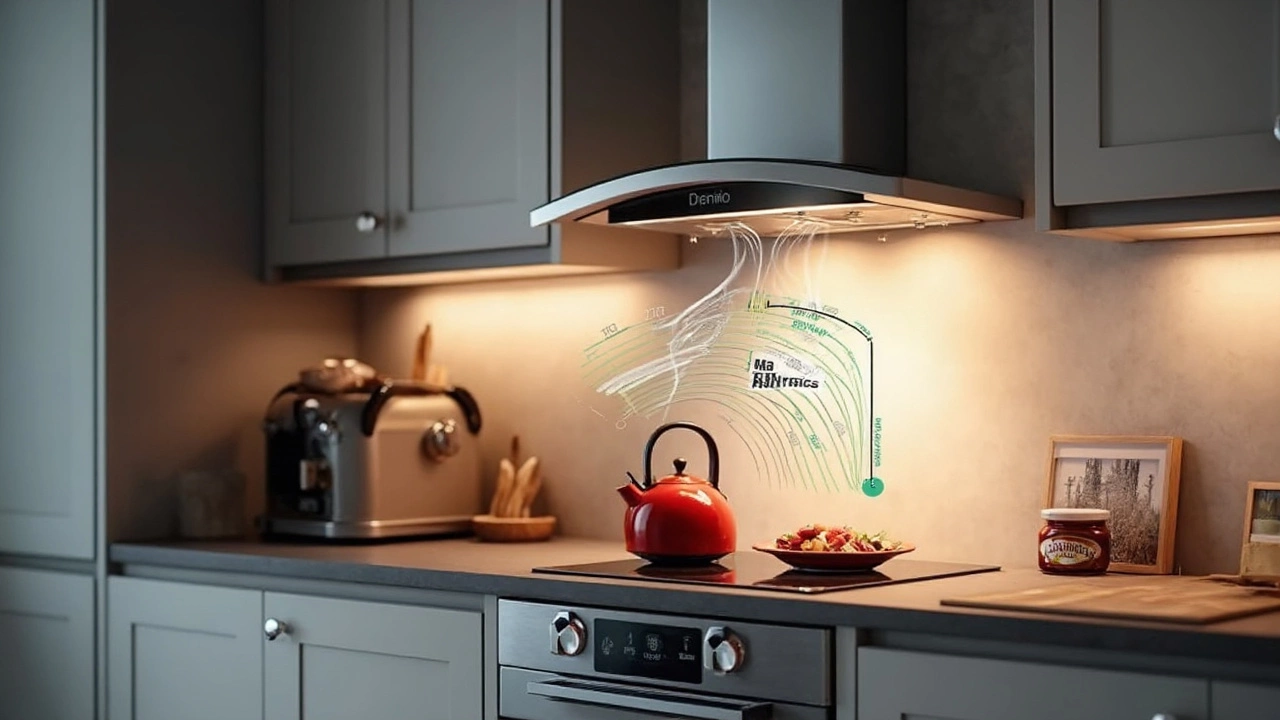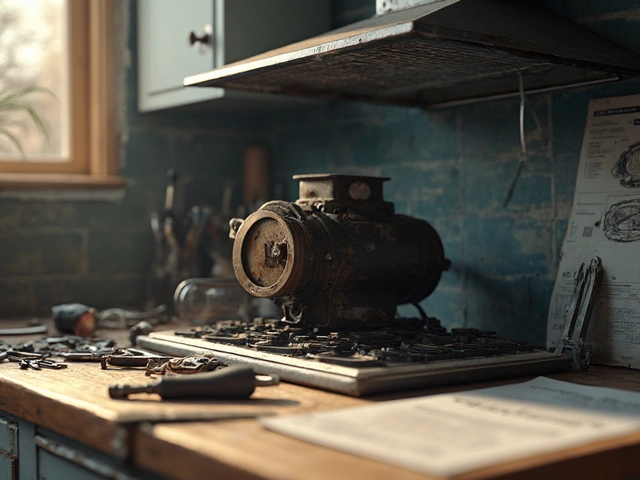Ever walked into a room and felt the humidity slap you in the face? That's probably because the extractor fan isn't doing its job, or maybe there isn't one at all. Picking the right extractor fan is crucial for keeping your space fresh and comfortable. But with so many types and features out there, it can get confusing.
First things first, know what you're dealing with. Extractor fans come in several types, and each has its own perks. Think about where you'll be using it. Got a steamy bathroom? You'll need one that's moisture-resistant. Thick, greasy kitchen air? You'll want something with a bit more power.
Size matters too. A fan that's too small won't do much, and one that's too big could just turn your room into a wind tunnel. There's a calculation involved, but don't worry – it’s simpler than it sounds. Basically, you’re matching fan size with room volume. Easy peasy once you get the hang of it.
- Understanding Fan Types
- Sizing Your Extractor Fan
- Noise Levels and Efficiency
- Essential Features to Consider
- Maintenance Tips
- FAQs on Extractor Fans
Understanding Fan Types
When it comes to extractor fans, not all fans are created equal. The type you choose can significantly impact your ventilation efficiency and, ultimately, your comfort. Let’s dig into some key types you'll come across.
Axial Fans
These are probably what most folks think of when they hear 'fan.' Axial fans are perfect for moving air over short distances, making them an ideal choice for small bathrooms or utility rooms. They usually mount on the window or ceiling and are pretty straightforward in design.
Centrifugal Fans
Looking for a bit more oomph? Centrifugal fans push air at a higher pressure, allowing them to tackle longer ducting runs. If your bathroom or kitchen has ductwork that twists and turns, this fan type can power through those obstacles. Just remember, with great power comes — you guessed it — more noise.
Inline Fans
For a balanced approach, there's inline fans. They sit within the ductwork, quietly humming. Ideal for when you want to keep the noise down. These often work when direct installation isn't feasible, like in cases where behind-the-wall setups are necessary.
Wall-Mounted Fans
Sometimes, the easiest option is to mount it right on an exterior wall. These fans effectively discharge air directly outside and are often found in kitchens where there’s plenty of steam and odors to evacuate promptly.
Kitchen Hood Fans
Speaking of kitchens, range hood or cooker hood fans are designed precisely to lift smoke, heat, and cooking odors away. They're an essential appliance if you're into frying or heavy cooking.
| Fan Type | Best Use |
|---|---|
| Axial Fans | Short distances, small rooms |
| Centrifugal Fans | Long ducting, high pressure |
| Inline Fans | Quiet operation, duct installation |
| Wall-Mounted Fans | Direct outdoor discharge |
| Kitchen Hood Fans | Cooking areas |
Choosing the right type of fan boils down to your specific needs and setup. Consider where you plan to install it and the function it needs to serve. After all, nobody wants an echo chamber in the bathroom or a silent underperformer in the kitchen.
Sizing Your Extractor Fan
Getting the size right for your extractor fan is a game-changer. You don't want a noisy hurricane in your bathroom or a fan weaker than a whisper in your kitchen. But how do you pick the right size? It's all about volume – the room's volume, that is. Let's break it down.
Step 1: Measure Your Room
Start by grabbing a tape measure and getting the dimensions of the room. You need to know the length, width, and height. Multiply these numbers together to get your room's volume. For example, a room that's 2 meters wide, 3 meters long, and 2.5 meters high would have a volume of 15 cubic meters.
Step 2: Know Your Air Changes Per Hour (ACH)
Once you've got the volume, think about how fast you need the air to circulate. This is measured in Air Changes per Hour (ACH). Bathrooms typically need 8 to 12 ACH, while kitchens often need 15 to 20 ACH. It depends on how frequently you'll be using the room and how much steam or smoke it generates.
Step 3: Calculate the Ideal Fan Size
To find out the minimum extraction rate your fan needs, multiply the volume by the appropriate ACH. So, for our 15 cubic meter bathroom needing 10 ACH, you’d want a fan with a minimum rate of 150 cubic meters per hour (m³/h).
Here's a quick reference table to give you an idea:
| Room Type | Volume (m³) | Recommended ACH | Required Extraction Rate (m³/h) |
|---|---|---|---|
| Small Bathroom | 10 | 8-12 | 80-120 |
| Medium Kitchen | 18 | 15-20 | 270-360 |
Get yourself a fan with at least the minimum extraction rate you just calculated, and you’ll be golden. It's really that simple. Just remember: too strong, and you're wasting energy; too weak, and you won't get the fresh air you need.
Noise Levels and Efficiency
When it comes to picking the right extractor fan, considering noise levels can be a game-changer. Imagine the hum of a fan that sounds more like a jet engine—not fun, especially in a cozy space like your bathroom or kitchen. The good news is, most modern fans are designed to be quieter, and you can tell how loud they’ll be by checking the decibel (dB) rating. Generally, fans below 30 dB are considered whisper-quiet, while those above 60 dB might not be your best bet for a peaceful atmosphere.
Another angle to look at is efficiency, particularly if you're concerned about energy bills. An efficient fan does the job without sending your electricity usage through the roof. Look for the energy label; an A-rated fan is often your friend here. These fans are designed to run without consuming loads of power, which means they're easier on both the environment and your wallet.
Balancing Performance and Quietness
It’s a balancing act. You want to ensure the fan has enough power to ventilate properly, yet doesn't dominate the soundscape of your space. Opt for fans that come with specific technology aimed at noise reduction. Features like ball-bearing motors or mixed flow technology can help make the fan powerful yet quiet.
Investing for the Long Haul
Spending a bit more on a highly efficient unit can pay off in the long run. Some people go for cheaper models and end up with higher energy bills or more frequent breakdowns, leading to repairs, which can be an expense of their own. Read up on warranties; some brands offer extensive coverage, which can be a lifesaver.
| Noise Level | Environment |
|---|---|
| Below 30 dB | Ideal for quiet spaces like bedrooms |
| 30-50 dB | Suitable for kitchens and bathrooms |
| Above 60 dB | Better for industrial or more isolated areas |

Essential Features to Consider
When it comes to choosing the perfect extractor fan, it's not just about getting any fan that fits the bill. You want to zero in on features that actually matter. Let's break down what you should be looking for.
Air Extraction Rate
This is the bread and butter of an extractor fan. It's all about how much air the fan can shift, measured in cubic meters per hour (m³/h). Bigger spaces need fans with higher extraction rates. For instance, a kitchen might need something around 250 m³/h or more, while a small bathroom could do with a bit less.
Noise Level
Nobody wants a fan that's louder than their favorite podcast. Check the decibels (dB) – something under 30 dB is whisper-quiet, while over 40 dB might feel like you’re at an airport. If you’re noise-sensitive, definitely aim for the quieter end of the spectrum.
Energy Efficiency
You don’t want your new fan sending your energy bills through the roof. Look for models with energy-saving features. Fans that boast the Energy Star label are generally a good bet because they meet efficiency standards.
Timer and Humidity Sensors
A timer can let you set and forget, making sure the fan runs just long enough to do its job without wasting power. Humidity sensors are perfect for bathrooms that get all steamy. They kick the fan on when things get too damp and shut it off when it’s no longer needed. Handy, right?
Backdraft Shutter
You wouldn’t want cold air rushing in when you're trying to keep it out, would you? A backdraft shutter prevents unwanted drafts and helps keep the temperature inside just right.
| Feature | Benefit |
|---|---|
| Timer | Prevents energy wastage |
| Humidity Sensor | Automatic moisture control |
| Backdraft Shutter | Keeps air from flowing back |
All of these might sound like a lot, but trusting me, ticking these boxes means you'll end up with a fan that's efficient, effective, and won’t drive you up the wall with noise. Make sure to pick features customizable to your own needs, and you'll be golden.
Maintenance Tips
Keeping your extractor fan in top shape doesn't have to be a chore. A little regular maintenance goes a long way. You don’t need to be a pro to handle most of these tasks.
Regular Cleaning
Caring for your fan begins with regular cleaning. Dust and grime can really build up, especially in high-moisture areas like bathrooms. Unplug the fan and use a soft cloth to wipe down surfaces. Don’t overlook the grille—a small brush or even an old toothbrush can help dislodge stubborn dirt.
A study from Home Ventilation Institute found that routine cleaning can extend the life of home appliances by up to 25%.
Tighten Up Loose Ends
Next, ensure all screws and bolts are still snug. Over time, fans can start to rattle if things get loose. A screwdriver and a few minutes are all you need.
Check for Wear
Inspect the fan blades occasionally for any signs of wear or damage. These might seem small, but even minor dings can affect performance over time. Replace damaged parts as soon as you notice them.
“A well-maintained extractor fan not only improves air quality but can also lower energy bills by running more efficiently.” — John Pembroke, HVAC specialist.
Listen for Unusual Noises
A healthy extractor fan should hum gently. If you start hearing strange sounds, it might be time to look under the hood. Unusual noises can indicate issues like motor wear or loose components.
Fan Efficiency Table
| Task | Frequency | Impact on Efficiency |
|---|---|---|
| Cleaning | Monthly | Improves air quality |
| Screw Tightening | Quarterly | Prevents rattles |
| Blade Inspection | Semi-annually | Keeps performance optimal |
| Noise Check | Monthly | Catches issues early |
By following these tips, you'll be keeping your space fresh and your fan working effectively. The added bonus? You’ll probably save some cash on repairs in the long run!
FAQs on Extractor Fans
Extractor fans might seem straightforward, but doubts often pop up. Here, we dive into some of the most common questions people have when shopping for or maintaining an extractor fan.
How do I choose the right size?
Size is crucial! The fan needs to match the room size. You typically calculate the air volume of the room (length x width x height) and then aim for a fan that can exchange the air 6-10 times per hour. For instance, if your bathroom has a volume of 20m³, go for a fan with a capacity of around 120-200m³/hr.
What's the difference between axial and centrifugal fans?
Great question! Axial fans are best for walls and windows, moving air directly. Perfect for shorter ventilation routes. Centrifugal fans, however, are stronger and can handle long duct runs, making them ideal for kitchens or internal rooms.
Are some fans quieter than others?
Absolutely! If noise bugs you, look for fans with low decibel ratings. Quieter models might cost a bit more but can make a world of difference in peaceful moments.
How often should I maintain my fan?
Maintenance ensures your fan keeps pulling its weight. A once-over every 6 months is usually enough – clean off dust, wipe the blades, and check the connections. If you notice any odd noises, it’s time to inspect more thoroughly.
Can extractor fans save on energy bills?
Yep! Modern fans are often more energy-efficient than older models. Look for fans with the Energy Star rating – they’ll offer good ventilation without skyrocketing your bills. Some may even have trickle functions to help them run more efficiently during low-traffic times.
| Fan Feature | Benefits |
|---|---|
| Energy Saving | Reduces power consumption, saving money |
| Noise Control | Ensures a quieter environment |
| Moisture Resistance | Prevents humidity build-up, ideal for bathrooms |




